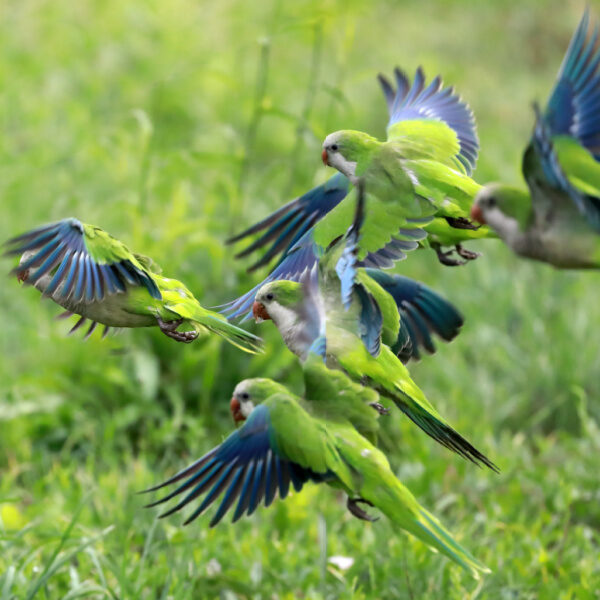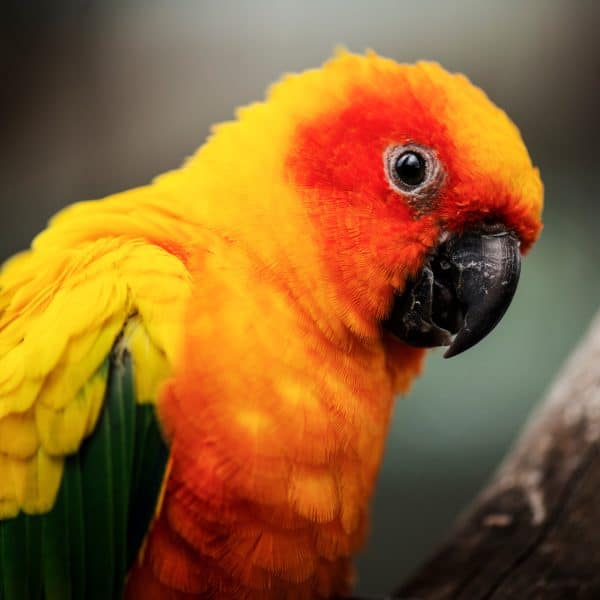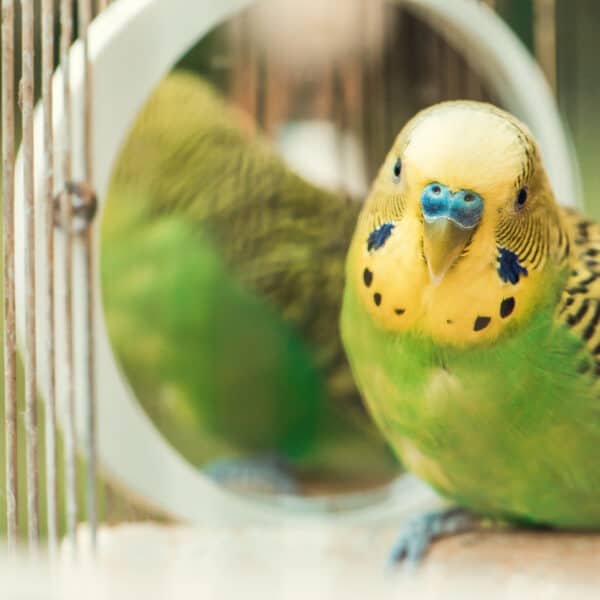
How Often and How Much Time Should I Interact With My Parrot?
Last Updated on by Mitch Rezman
And what actions should I take when face to face with the bird?
As highly social and intelligent animals, parrots thrive on regular interaction with their human caregivers.
Editors note: they are animals and must be treated as animals as if it’s they’re very core ~ which it is. endnote
The amount of interaction and the specific activities you engage in with your parrot will depend on the species, the individual bird’s personality, and your own schedule.
Let’s back up a little.
If you’re a workaholic with a 12 to 18-hour-a-day schedule don’t get a parrot. If you’re a first responder on a rotating schedule, God bless but don’t get a parrot.
If you want to be vacuuming tiny feathers, seeds, husks, and food particulate ~ an aviary filled with budgies will fit the bill.
They are beautiful to look at and even if they don’t talk they converse with one another.
That’s not something I plucked out of the air (not that I ever do that).
Watch this video and learn how the largest flock of Budgies in the world communicates information on food sources and dangerous areas with predators.
Editors note: “Grass and grass seed, is the staple of a budgerigars diet.” I say to those who insist that an all-seed diet will kill your bird. Let them have their seeds. Endnote
There are some general guidelines you can follow to ensure that your parrot receives the socialization and mental stimulation it needs, sort of on a good day:
- Daily Interaction: Aim to interact with your parrot for at least one to two hours each day, if possible. This interaction can be broken up into shorter sessions throughout the day. Keep in mind that some parrots may require more interaction than others, so it’s important to pay attention to your bird’s behavior and adjust as needed.
- Out-of-Cage Time: Allow your parrot to spend time outside of its cage each day. This gives the bird an opportunity to stretch its wings, explore, and interact with you and other members of the household. Make sure the room is bird-safe (e.g., no open windows or doors, no toxic plants, no ceiling fans running) before letting your parrot out.
- Play and Enrichment: Provide a variety of toys and enrichment activities for your parrot. This can include puzzle toys, foraging toys, chew toys, and more. Rotate the toys regularly to keep things interesting. You can also play games with your parrot, such as hide-and-seek or fetch. And don’t forget the treats.
- Training: Positive reinforcement training is a great way to bond with your parrot and teach it new behaviors. You can use clicker training or other reward-based methods to teach your parrot tricks, commands, and good manners. Training sessions should be short and fun and always end on a positive note.
- Communication: Parrots are excellent communicators and many species can mimic human speech. Spend time talking to your parrot, and encourage it to talk back to you. You can teach your parrot specific words and phrases, or simply have a “conversation” with your bird.
- Physical Contact: Some parrots enjoy being petted and cuddled, while others may prefer to perch on your shoulder or arm. Pay attention to your bird’s body language and preferences, and respect its boundaries. Never force physical contact if your parrot is uncomfortable.
- Socialization: If possible, expose your parrot to different people, environments, and experiences. This can help prevent fear and aggression and promote a well-adjusted, confident bird. Always supervise interactions between your parrot and other people or pets.
Remember that each parrot is an individual, and what works for one bird may not work for another.
It’s important to be patient, observant, and responsive to your parrot’s needs.
The word “patient” Is a really complicated word to define.
We have 8 rescue parrots and 3 Hoosierdaddy juveniles, no, just kidding we know it was Waffles, always wanted to use that word in a sentence of mine.
Building a strong, trusting relationship with your parrot takes time and effort, but the rewards are well worth it.
That said ~ Keep your expectations low.
We cannot interact directly with any of the eight budgies.
They know we feed and water them so they don’t freak out when our arms are in the cage but they won’t hop on our hand ~ they tolerate us.
It’s extraordinarily entertaining listening to the chatter and we do let them out for 30 minutes to 2 or 3 hours per day while we’re chasing them away from potentially destructive areas there’s a blog post on that.
Keto our right neck we’ve had for almost 5 years, he’s probably 19 20 21 years old but he cannot come in contact with flesh, if he does he bites, it’s something that he learned before we took him in.
He will not only bite but his beak becomes a 4 razor-bladed vise-grip.
The first time it happened I shook him off violently, fortunately, he didn’t hurt himself but we realize that he does have an injured wing and it wasn’t from us, but he can still fly. He holds it at a slight angle. We are able to move him with a toy and a stick perch and he is happy he can be within 6 inches to a foot away, but we have to have the toy and or the perch.
Chili and Barney the Quaker and the cockatiel are total opposites.
Chili will engage ANYONE – he’ll nip now and then which will cause us to shake him off to his cage.
Barney “hates” everyone except for when I’m gone for more than a day on business, then he “loves” Catherine.
Birds are Amoral, You can’t “punish” birds.
I hear humans yell “no” or “no bite” when their pet birds commit negative behavior i.e. bite a human or chew a piece of furniture.
That always triggers two rhetorical questions.
How many lessons on morality has your bird taken?
How many hours have you spent teaching your bird the meaning of “no.”
So while you’re yelling “No” your bird is thinking “Finally, they’re talking to me yippee.”
In conclusion,
“Lockdown” in a cage as “punishment” is worthless.
Birds with lifespans in decades literally invented the word “patience.”
We rescued a female Senegal parrot (surgically sexed) that patiently waited in the same small cage with 30 minutes of out-of-the-birdcage playtime a day to be rescued, for seven freaking years!
Bird cages are not jails, they must be a place that the bird feels comfortable entering in then with the certain expectation of leaving freely during a certain time frame based upon your well-regulated actions in the practice of animal husbandry.
Your expectations for the degree of intimacy your pet birds will engage with you is totally unpredictable and must be approached with low expectations so I can’t come close to answering the question posed.
Written by Mitch Rezman
Approved by Catherine Tobsing
Author Profile
Latest entries
 The Traveling BirdJune 26, 2025Can You Name 5 Parrot Species That Are Living Wild in the USA?
The Traveling BirdJune 26, 2025Can You Name 5 Parrot Species That Are Living Wild in the USA? Bird BehaviorJune 26, 2025How is it Parrots Are Problem Solvers Social Animals and Even Use Tools?
Bird BehaviorJune 26, 2025How is it Parrots Are Problem Solvers Social Animals and Even Use Tools? Bird & Parrot AnatomyJune 25, 2025How a Tiny Chemical Modification Makes Parrots Nature’s Living Paintings
Bird & Parrot AnatomyJune 25, 2025How a Tiny Chemical Modification Makes Parrots Nature’s Living Paintings PigeonsJune 20, 2025How Do Parrots Thrive in Cities Outside Their Native Habitats?
PigeonsJune 20, 2025How Do Parrots Thrive in Cities Outside Their Native Habitats?


